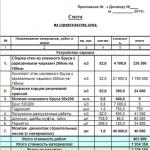What does the UPP vector plant produce? Open Joint Stock Company "Ural Production Enterprise "Vector" (OJSC UPP "Vector"). Military products
Brief historical backgroundabout organization and activities
JSC"Ural manufacturing enterprise"Vector"
The plant originates from the mechanical workshops at the General Headquarters of the Russian Army in St. Petersburg, which were created in 1811. This year, the project of Doctor of Astronomy and Physics Cornel Reissig was approved to create mechanical workshops at the Quartermaster Unit (Managing Adjutant General Prince P .M.Volkonsky) in the structure of the Military Topographical Depot of St. Petersburg. The workshop began producing mathematical and geodetic instruments for the Quartermaster Unit, Map Depot and Engineering Department.
1811 is the official date of creation and start of activity of the mechanical workshop, which became the date of birth of UPP Vector JSC.
According to the testimony of a famous military surveyor, the entire workshop was under the main command of the Minister of War throughout the campaigns against Emperor Napoleon. The mechanical workshop reached its greatest prosperity in the 40-50s of the 19th century. Optical-mechanical instruments manufactured in the Workshop were very popular. At exhibitions, the Workshop's instruments have repeatedly received diplomas and incentive prizes. Compassos, mensulae and cypragels of the latest type were sent to the 1874 World Exhibition in Vienna. For the 1882 exhibition - levels, small scales. At the 1896 exhibition - scales, levels, compasses and barometers. The mechanical workshop was located in St. Petersburg until 1918. She had to evacuate to Tashkent, where she worked for 6 years.
In 1918, the workshop was transferred to Tashkent. During this period, shock tubes for projectiles, steering shells for screw cartridges, equipment for the Kauninsky powder factory, shuttles for weaving and sewing machines Voenzag enterprises; repair and install metographic machines for printing banknotes (Turkbon), prosthetics for war invalids.
In 1923, the workshop was relocated to Moscow. In 1925, the workshop was renamed the Geodesy precision mechanics factory, which became part of the Geokartprom trust. In 1927 she received a 1st degree Diploma at a lighting exhibition in Moscow at the Polytechnic Museum. In 1933 it received the status of the Geodesy plant. The plant continued the production of optical instruments, repairs cameras of the "POTTE" system, and begins production Soviet cameras"Leica" and aerial cameras.
In 1940, the Geodesy plant was renamed the Union State Plant No. 356 of the 2nd Main Directorate of the People's Commissar of Armaments of the USSR.
In August 1941, the plant was evacuated from Moscow to Sverdlovsk and on October 1, 1941, it shipped its first products for the needs of the Army.
October 1, 1941 is the official date of commencement of the plant’s activities on the Ural soil.
During the Great Patriotic War the plant produced products for the needs of the army, incl. aerial cameras for daytime and night shooting AFA type, necessary equipment for developing and printing photographs, etc.
In 1949, the plant was repurposed from an optical-mechanical profile to a radar profile and was designated as the head plant for radar meteorological stations for the needs of the Ministry of Defense and the USSR Hydrometeorological Service. At the same time, by Government Decree, a Special Design Bureau (SDB) was created at the enterprise with the functions of development and design support for the production of radar-related products.
Since 1951, the enterprise began serial production of the country's first artillery gun-targeting radar station, SON-4. In subsequent years they were put into production radar stations SON-4A, SON-9, SON-9A, SON-15.
The production of radar equipment new to the enterprise was ensured by the targeted assignment of young specialists from many universities in the country, radio engineering and instrument engineering faculties, to the enterprise. The management and engineering personnel of the enterprise underwent retraining at academic courses in Moscow.
Since 1957, the company has significantly expanded its range of radar products. The Ministry of Radio Industry assigned to the enterprise the direction of creating and mastering the production of meteorological products. In the same year, the first radar meteorological station RMS-1 “Meteor” (developed by NIEMI, Moscow) was transferred to the enterprise for production. On the basis of this station, the plant's Design Bureau developed radar meteorological stations for the network of the country's hydrometeorological service "Meteorit", "Meteorit-2" and "Meteorit-R", which have proven themselves when working in extreme conditions of the Arctic and Antarctic, as well as for scientific research. -research vessels of the USSR Academy of Sciences.
In 1959, the enterprise developed and serially produced from 1961 to 1967 the radar meteorological wind sounding station RVZ-1 “Proba”.
In 1966, the enterprise was awarded the Order of the Red Banner of Labor.
In 1971, the enterprise's design bureau began developing a mobile radar meteorological complex at electronic database new generation "Shkval-1". Further modernization of the product made it possible to master the production of the product: “Shkval-2”, radio direction-finding meteorological complex (RPMK) “Ulybka”, operating in both radar and direction-finding modes. Based on the “Shkval” and “Smile” products, the AVK-1 “Titan” and AVK-1M “Titan-M” radar complexes were developed for the fixed network of the country’s Hydrometeorological Service, replacing the physically and morally outdated “Meteorites”.
In 1975, the plant, increasing its volumes serial production mastered special equipment products, formed a new direction in consumer goods - electromusical and amplification-acoustic equipment, which was successfully sold on the country's market. The plant entered perestroika times, there was a sharp decrease in the volume of government orders and the enterprise found itself in a very difficult situation. At that time the most mass production for civilian purposes there were electromusical subjects and household computers. They could not cover the lost production volumes, as a result the plant found itself in a very difficult situation. Communication equipment was already being produced in small quantities. IN short term the plant managed to repurpose part of its production and, despite an acute financial deficit, invest in the development and organization of production of new products. The main volumes were provided by communication equipment. In 1995, the company was awarded a diploma from the International Academy of Business Leadership and Management. The State Enterprise “Vector” received this award “For success in economic survival and development in unfavorable conditions.”
Throughout its 200-year history, the plant has always been distinguished by the excellent quality of its products and the high professionalism of its employees. For great contribution to production modern technology for the Armed Forces of the country, many workers of the enterprise were awarded government awards: Heroes of Socialist Labor - 3 people; State Prize laureates - 6 people; awarded the Order of Lenin - 12 people; awarded the Order of the October Revolution - 21 people; awarded the Order of the Red Banner of Labor - 112 people; awarded the Order of the Badge of Honor - 150 people; awarded the Order of Labor Glory, II degree - 150 people; III degree - 133 people; awarded the Medal for Labor Valor - 150 people; 184 people were awarded the Medal for Labor Distinction.
The history of the plant began in 1811, when workshops for the repair and production of geodetic instruments were organized in St. Petersburg. In 1941, by decision of the Defense Council, the plant was transferred to Sverdlovsk and already on October 1, 1941, began producing cameras for aerial photography, which the Soviet army needed. The first reconstruction of the plant was carried out in 1949, the profile was changed to radar, and the plant became the leading plant for the production of meteorological stations for the needs of the Ministry of Defense, the Hydrometeorological Service of the USSR and for research purposes. Based on these technologies, digital computing technology has been mastered since 1965, and large automated systems controls used in our country and exported. Currently, OJSC UPP Vector is modern enterprise, which has a powerful production potential, a wide range advanced technologies, high professional level of personnel, proven product quality control system. The company is constantly searching promising species products that could be successfully sold on domestic market. Thus, for almost 15 years the plant was practically a monopolist in the production of domestic electric musical instruments and sound amplification equipment. Today our company works closely with developers radio-electronic equipment, such as OKB "Peleng", MF "Tariff", CJSC "NTC-Simos", CJSC "ASK", UNPP "Lazer", CJSC "Vector-MS" and others. Currently, telecommunications equipment produced by the enterprise has occupied a strong place in the market. Modern developments include elevator equipment, air plasma cutting devices, lifting and transport equipment, electrical equipment for urban electric transport, and medical equipment. Many years of experience in the field of radio electronics allowed the company to master and constantly expand the range of products for industrial, technical and household purposes, the development of which is a response to market demand. The Vector plant is part of the Almaz-ANTEY air defense concern.
Open Joint-Stock Company"Ural Production Enterprise "Vector" (JSC UPP "Vector")
OJSC UPP Vector is a modern enterprise with powerful production potential, a wide range of advanced technologies, a high professional level of personnel, and a proven product quality control system.
The company is constantly searching for promising types of products that could be successfully sold on the domestic market. Thus, for almost 15 years, the plant was practically a monopolist in the production of domestic electric musical instruments and sound amplification equipment. Today, our company closely cooperates with developers of radio-electronic equipment, such as OKB Peleng, MF Tarif, CJSC NTC-Simos, CJSC ASK, UNPP Lazer, CJSC Vector-MS, etc.
Currently, telecommunications equipment produced by the enterprise has occupied a strong place in the market.
Modern developments include elevator equipment, air plasma cutting devices, lifting and transport equipment, electrical equipment for urban electric transport, and medical equipment.
Many years of experience in the field of radio electronics have allowed the company to master and constantly expand the range of products for industrial, technical and household purposes, the development of which is a response to market demand.
Story
The history of the plant began in 1811, when workshops for the repair and production of geodetic instruments were organized in St. Petersburg.
In 1941, by decision of the Defense Council, the plant was transferred to Sverdlovsk and already on October 1, 1941, began producing cameras for aerial photography, which the Soviet army needed.
The first reconstruction of the plant was carried out in 1949, the profile was changed to radar, and the plant became the leading plant for the production of meteorological stations for the needs of the Ministry of Defense, the Hydrometeorological Service of the USSR, and for research purposes. Based on these technologies, digital computing technology has been mastered since 1965, and large automated control systems used in our country and exported are produced on its basis.
1811 St. Petersburg. Establishment of workshops for the manufacture and repair of geodetic instruments. The workshops were part of the structure of the Military Topographical Depot, subordinate to the Minister of War, then to the General Staff.
1918 Tashkent. The workshops, transferred to Tashkent, were renamed the Geodesy factory.
1923 Moscow. The Geodesy factory, transferred to Moscow, was renamed the Geodesy plant, which produced geodetic instruments, aerial cameras, and Leika cameras.
1941 In August, plant No. 356 was transferred to Sverdlovsk and located on the premises of a former pasta factory, and on October 1, 1941, the plant produced the first batch of products for the needs of the army, including cameras for aerial photography of the AFA type.
1949 Sverdlovsk. Plant No. 356 was repurposed for a radar profile and was designated as the head office for radar meteorological stations for the needs of the Ministry of Defense and Hydromet, as well as other products on this base for the Ministry of Defense.
1957 Sverdlovsk. The plant began serial production of the RMS-1 Meteor radar meteorological station, which for a long time was supplied to various countries around the world, including scientific research on sea vessels to the Arctic and Antarctic.
1960 Sverdlovsk. The plant begins development and production of new radar systems for the needs of the Ministry of Defense. For these purposes, a new modern building is being built along Malysheva Street, which is equipped with new equipment.
1965 Sverdlovsk. The plant is mastering a new direction - digital computer technology, a new element base - ferrite-transistor cells and based on it produces automated control and information systems.
1975 The plant, increasing the volume of serial production of mastered special equipment products, formed a new direction for consumer goods - electromusical and amplifying-acoustic equipment, which is successfully sold on the USSR market.
1989 to date - The plant develops and produces new conversion products: telecommunications equipment, industrial and technical products, medical equipment and consumer goods
Military products
- Radiosondes meteorological
- Radio direction-finding meteorological complexes RPMK-1 (1B44) “Smile”
- Radar systems for reconnaissance of enemy artillery positions and control of firing of own fire weapons “Zoo-1” (1L219)
Civil products:
- Payphone equipment
- Radio relay equipment
- Equipment digital systems transfers
- Household computers, disk drives, joysticks
- Starter chargers
- Electrical cords with plug, extension cords
- Gas and electric gas stoves, gas cylinder connecting devices
- Furniture and furniture fittings
- Microplasma installation for cutting and welding metals
- Electric forklift power supply system
- Travel switches, blocking switches
- Freight and passenger elevator control devices
- Push-button posts
- Light boards






